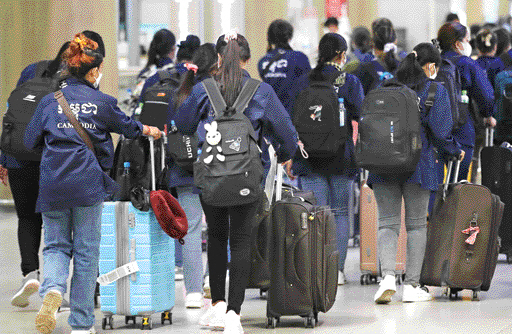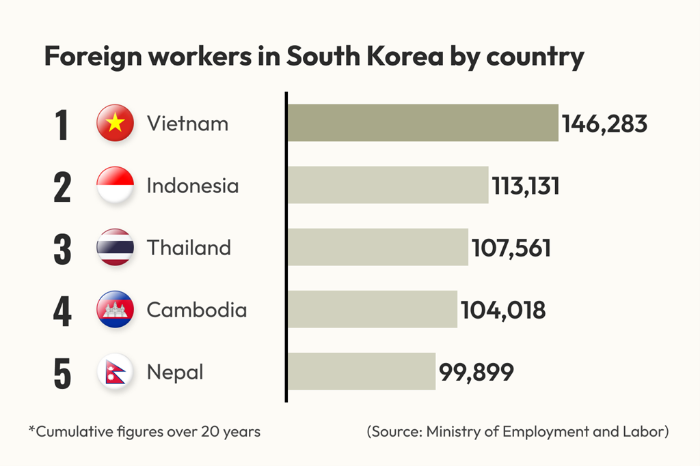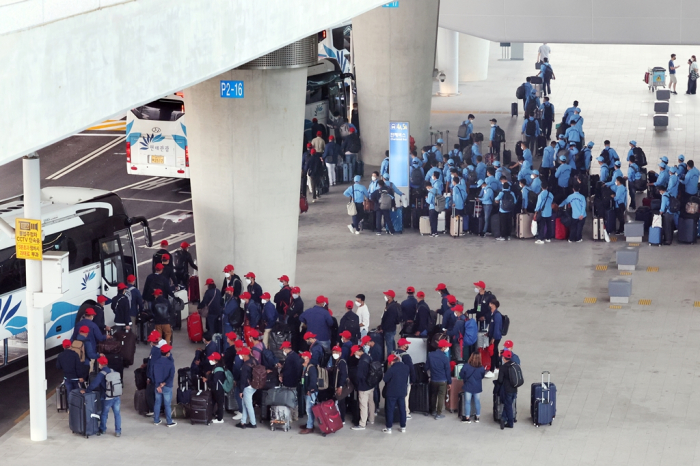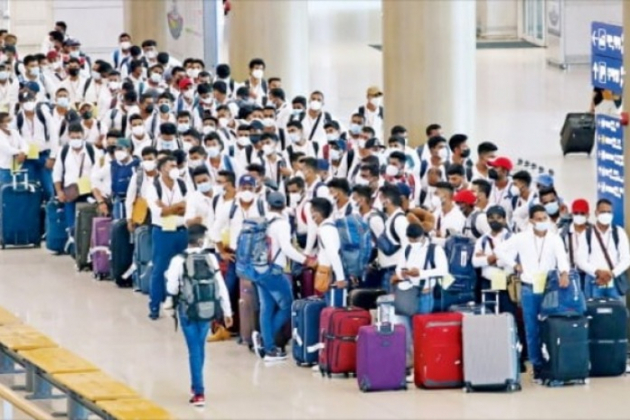Economy
Vietnamese lead influx of foreign workers with Korean dream
Over 1 million foreign workers have been employed in sectors mostly shunned by Koreans over the past two decades
By Aug 19, 2024 (Gmt+09:00)
4
Min read
Most Read
LG Chem to sell water filter business to Glenwood PE for $692 million


Kyobo Life poised to buy Japan’s SBI Group-owned savings bank


KT&G eyes overseas M&A after rejecting activist fund's offer


StockX in merger talks with Naver’s online reseller Kream


Mirae Asset to be named Korea Post’s core real estate fund operator



On Aug. 31, 2004, 92 Filipinos, wearing T-shirts and white caps, entered Incheon International Airport determined to make money in South Korea and return home with a fortune.
Those Philippine workers with the Korean dream were the first batch of foreigners allowed to set foot on Korean soil, a relatively better-off country, under Korea’s foreign employment permit system (EPS) introduced a couple of weeks earlier.
Twenty years later, the number of EPS-based foreign workers has surpassed 1 million. Today they perform a critical role across industries that Koreans mostly shun due to their labor-intensive work and low salaries.
According to the Ministry of Employment and Labor, the total number of foreign workers who have been allowed to enter Korea under the EPS stood at 1,001,106 as of the end of June, up from 961,347 six months earlier.
Foreign workers from 17 countries have been working in five permitted sectors: manufacturing, construction, agriculture, fisheries and services.

Currently, 247,191 foreign workers work in those industries, accounting for 4.6% of these industries’ entire workforce.
VIETNAMESE LEADING THE PACK
Over the past two decades, a total of 4,846,935 foreigners from 17 countries that signed a worker dispatch agreement with Korea have taken tests in work skills and Korean language proficiency to try and obtain an E-9 visa necessary to work in Korea. Of these, 1,001,106 people passed the tests and were deployed to 79,399 workplaces around the country, supporting the manufacturing, construction, agriculture, livestock and fisheries industries that Koreans avoid.
Vietnam has sent the most workers, with 146,283 people arriving in Korea over the past 20 years. At its peak, 20,075 Vietnamese entered Incheon International Airport in 2008.
Indonesia came in second with 113,131 workers coming to Korea over two decades, followed by Thailand (107,561), Cambodia (104,018) and Nepal (99,899).

Of the 247,191 foreigners working under Korea's EPS in 2023, 80.6% or 199,269 people were engaged in manufacturing, followed by 29,250 in the agricultural and livestock industry and 11,191 in the fisheries sector.
The government has increased the number of foreign workers allowed this year to 165,000 — the largest ever.
Starting this year, foreign workers can also work in sectors such as hotels, condominiums, restaurants, meat transport, waste disposal, courier services and airport ground handling.
VIETNAMESE CLOSING GAP WITH CHINESE
With the Vietnamese topping the list of foreign entrants, the proportions of foreigners, overwhelmingly Chinese for many years, is changing.
As of the end of June, the number of Chinese residents, including immigrants by marriage, overseas students and workers with a work permit, reached 952,254 — the largest figure ever and more than three times that of the second-ranking Vietnamese with 307,487.
However, excluding the 635,215 Chinese who are ethnically Korean, Chinese residents in Korea stood at 317,039.

Among marriage immigrants, Chinese numbered 60,281. Excluding the ethnic Korean Chinese, however, that number fell to 39,009 — fewer than the Vietnamese (41,028).
Across all types of foreign workers, including skilled workers with the E-7 visa, seasonal workers with the E-8 visa and unskilled E-9 workers, Chinese residents numbered 97,385, more than the Vietnamese (81,744). But when excluding the ethnic Korean Chinese, the Vietnamese ranked first.
CONCENTRATED IN SEOUL METROPOLITAN AREA
Foreign workers prefer to work in Seoul and the surrounding metropolitan area where pay and living conditions are better than in other regions.
The proportion of workers employed in the Seoul metropolitan area increased to 48.7% in 2021 from 44.7% in 2012.

Last year, the 199,269 foreigners in the domestic manufacturing sector were estimated to have earned a combined 11 trillion won ($8.2 billion). That’s 2.5 times the 2022 GDP of Timor-Leste, one of the 17 countries that dispatch workers to Korea.
In 2017, the World Bank evaluated Korea’s foreign EPS as an outstanding policy that promotes economic growth in countries dispatching workers.
FOREIGN WORKERS SET TO GROW IN KOREA
Due to Korea’s low birth rate and aging population, foreign worker numbers are expected to continue to increase going forward.
Analysts said Korea now needs to address issues such as improving foreign workers’ on-the-job safety and human rights to make the system sustainable.
“To retain skilled foreign workers over the long term, Korea should provide them with better support programs such as bringing their families into Korea and comfortably settling them down in the local community,” said Lee Kyu-yong, a researcher at the Korea Labor Institute.
Write to Yeong-Hyo Jeong and Yong-Hee Kwak at hugh@hankyung.com
In-Soo Nam edited this article.
More to Read
-
 EconomyFilipino caregivers come to Korea amid demographic crisis
EconomyFilipino caregivers come to Korea amid demographic crisisJul 17, 2024 (Gmt+09:00)
2 Min read -
 ConstructionKorea gives the nod for foreign workers at plant construction sites
ConstructionKorea gives the nod for foreign workers at plant construction sitesFeb 14, 2024 (Gmt+09:00)
3 Min read -
 Culture & TrendsS.Korea needs 35,000 additional foreign workers: study
Culture & TrendsS.Korea needs 35,000 additional foreign workers: studyJan 08, 2024 (Gmt+09:00)
1 Min read -
 EconomyS.Korea to allow hiring of foreign workers in hotels, resorts
EconomyS.Korea to allow hiring of foreign workers in hotels, resortsDec 29, 2023 (Gmt+09:00)
1 Min read -

-
 EconomyKorea to retain more skilled foreign workers with visa status upgrade
EconomyKorea to retain more skilled foreign workers with visa status upgradeDec 16, 2022 (Gmt+09:00)
2 Min read -

Comment 0
LOG IN


